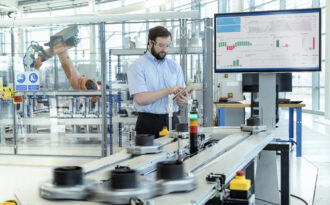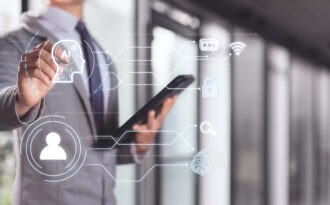

14 min lesen
February 8, 2024
AI and the Internet of Things (IoT) together form a powerful alliance with the potential to change our world fundamentally. This partnership enables intelligent actions derived from a flood of data, increasing efficiency, providing new insights, and revolutionising daily life and industrial processes.
The Internet of Things (IoT) is a revolutionary technology fundamentally transforming our lives and work. It describes a network of physical objects—from everyday household appliances to highly complex industrial systems—connected to the internet to collect, exchange, and act on data. These connected devices and sensors enable a new level of automation and efficiency in nearly every aspect of our lives.
The Internet of Things is based on the interconnection of devices that previously operated in isolation. Integrating AI and IoT creates intelligent systems that can learn from collected data and act autonomously. The applications of IoT range from smart home solutions that optimise energy consumption to Industry 4.0, where entire production processes can be monitored and controlled.
The combination of artificial intelligence and IoT, often referred to as AIoT, dramatically expands the possibilities of this technology by transforming machine data into valuable insights and precise decisions. The interaction between devices, sensors, and software allows for real-time information to be received and processes to be optimised accordingly. This integration leads to improved transparency, increased efficiency, and cost savings.
The challenges of implementing IoT solutions include security and privacy concerns, which can be addressed through AI-based data analysis and management systems. The digitisation and automation enabled by IoT open up new opportunities for businesses and individuals worldwide. The importance of the Internet of Things will continue to grow in the coming years as it serves as the foundation for numerous innovations across all industries.
Artificial Intelligence (AI) is a field of computer science focused on creating machines and systems that can perform tasks typically requiring human intelligence. This technology allows computers and automated systems to solve complex problems, recognise patterns, make decisions, and even conduct human-like interactions. AI is the backbone of many modern technologies, from smartphone speech recognition to self-driving cars.
The fundamentals of AI include various subfields such as:
Machine learning is a method of data analysis that enables computers to learn from experience and improve without explicit programming. Deep learning, a specialised machine learning, utilises complex neural networks with multiple layers to process and interpret large volumes of data.
These technologies form the foundation for developing intelligent systems capable of simulating human functions such as seeing, hearing, speaking, and decision-making. AI systems use these technologies to analyse vast amounts of data, identify patterns, and make predictions or decisions based on them.
The interaction between AI and IoT opens up new possibilities by enabling devices to collect and transmit data and analyse and act on it intelligently. This synergy leads to increased efficiency, improved user experiences, and the creation of systems capable of handling complex tasks with minimal human intervention.
Integrating artificial intelligence and the Internet of Things marks a revolutionary step in using and understanding technology. AI brings the ability to learn from data and make intelligent decisions, while IoT is the bridge that connects physical objects and systems to the Internet. This combination allows IoT applications not only to collect data, but also to understand it and act accordingly.
Edge computing is crucial in this integration as it brings data processing closer to the source, reduces response times, and minimises data transmission costs.
IoT and AI complement each other in multiple ways, creating synergies that enhance the efficiency and effectiveness of systems and processes across industries. Here are some examples of how these technologies work together:
The role of AI in the IoT goes far beyond simply analysing data. It enables IoT applications to act more intelligently, make autonomous decisions and optimise themselves.
Networking the Internet of Things with artificial intelligence creates an ecosystem in which devices collect data and understand and react to it. Companies use this synergy to make devices smarter, optimise processes and drive Industry 4.0 forward. While IoT is responsible for comprehensive data collection, AI analyses this IoT data, identifies patterns and initiates actions. This collaboration makes it possible to turn simple devices into adaptive systems that can make decisions autonomously, multiplying the benefits of the technology in numerous areas
The combination of Artificial Intelligence with the Internet of Things opens up a world of possibilities:
Despite the many benefits, implementing AI in IoT also presents challenges:
The future of AI and IoT promises exciting developments and innovations:
The combination of AI and IoT is a natural progression that has the potential to transform industries and everyday life. These technologies work hand in hand to create learning systems capable of autonomous decision-making, leading to a new era of efficiency and personalised applications.
IoT refers to networking physical devices with the internet to collect and share data. AI is concerned with creating machines that exhibit human-like intelligence and decision-making capabilities. Together, they enable intelligent systems that can act autonomously.
AI improves IoT through advanced data analysis, pattern recognition and autonomous decision-making, leading to more efficient and personalised solutions.
Challenges include privacy and security concerns, the complexity of system integration, the high energy consumption of AI applications and the need for standards to ensure compatibility and interoperability.
Future trends include edge computing, quantum computing, the development of digital twins, and improved AI algorithms developed specifically for IoT applications.

October 8, 2025
The biomethane sector is entering a decisive phase. Driven by climate targets, stricter regulations, and rising demand for renewable energy, the market is experiencing rapid growth. Yet, this expansion also creates new op...

February 3, 2025
The future of ERP lies in more efficient and flexible business solutions. In this article, you will discover how .NET-based ERP systems help you optimize processes while remaining adaptable. Explore the key benefits and technological advancemen...